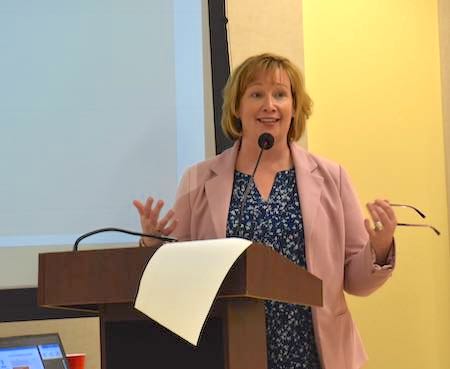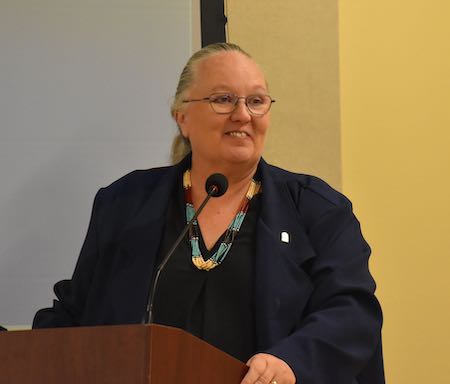Photos by Lynn Janes
Article by Mary Alice Murphy NM MFA representative Julie Halbig was featured speaker.
NM MFA representative Julie Halbig was featured speaker.
 Chamber Biard Member Sabrina Pack served as emcee.The Silver City-Grant County Chamber of Commerce held its monthly luncheon on March 7, 2024. Julie Halbig of the New Mexico Mortgage Finance Authority served as featured speaker.
Chamber Biard Member Sabrina Pack served as emcee.The Silver City-Grant County Chamber of Commerce held its monthly luncheon on March 7, 2024. Julie Halbig of the New Mexico Mortgage Finance Authority served as featured speaker.
Halbig, NMMFA director of compliance and initiatives, said the agency is reaching out all over the state "because we know that housing, and affordable housing in particular, is impacting all our communities. It will take all of us together to be the solution."
She said the MFA is a quasi-governmental agency created by an act of the Legislature to provide financing for everything housing-related for low- and moderate-income New Mexicans.
"In 2023 alone, we served almost 19,000 households," Halbig said. "We use funding from housing bonds, tax credits and federal and state programs to provide everything from down payment assistance to financing affordable housing construction and to rehabilitating homes to make them more energy efficient. We have more than 30 programs covering all continuums of affordable housing. We have more than 300 partners statewide, including lenders, real estate agents, nonprofit service providers, developers and local and tribal governments."
She noted the website for all things housing-related for low and moderate income families is https://housingnm.org/
She asked everyone attending to think about how they can collaborate with the MFA on housing issues to maximize what the MFA has to offer.
Halbig said affordable housing is a large part of economic development,. She said those who work every day, such as teachers, law enforcement, all need affordable housing.
Housing construction not only provides homes for residents, but it also creates jobs and brings in tax revenues, not only during construction but long-term from those living in the housing, whether it be single-family homes or multi-family units.
She showed a graph called a housing continuum, which addresses housing all the way from the homeless to the homeowners.
Halbig highlighted the most popular programs the MFA offers. "You have two shelters in your community and we're thankful for them. We get lots of calls, especially from families, so our programs includes the EHAP (emergency homeless assistance program). We also have the emergency rapid re-housing and homeless prevention, continuum of care, which is wrap-around services, and youth homelessness. When they're homeless they likely have other needs, too."
For transitional housing, "we work with landlords, so we can get youth coming out of foster care into supportive housing."
Halbig said the MFA also wants to put more dollars into recovery housing for those recovering from substance abuse disorder. "The Linkages program is totally funded by the state and provides permanent supportive housing with long-term rental subsidies, utility assistance and supportive wrap-around services to vulnerable populations, such as those with serious mental illness and includes Native Americans living off a reservation."
A small federal program provides housing opportunities for persons with AIDS.
She spent some time on the MFA rental development programs. "We often hear: 'How can we bring in right-sized apartment complexes into our community?' We want to be able to tell them they won't be able to tell the difference between the affordable multi-family housing we bring and the market-rate structures. One way is through a low-income housing tax credits. What is key is if you get a 9 precent low-income housing credit, you can pretty much cover the whole cost of the development of a multi-family complex. But you still have the 30 percent gap to get the project across the finish line."
[Editor's Note: She spoke so quickly that this writer could not keep up with her. This author recommends if you need any of these programs for housing needs to contact the MFA and learn the details and ask for help. This article gives the summaries of each program, as presented in the PowerPoint slides.]
The MFA offers many programs for funding rental development. They include Section 811, which provides project-based rental assistance for extremely low-income persons with disabilities who are linked with long-term services. Another is the 542(c) HUD and 539 Rural Development Risk Share, which are federal programs for multi-family loans permitting state HFAs (housing finance agencies) to process, underwrite and service loans and to manage and dispose of properties, which fall into default. Another program is the Section 8 Project Based Contract Administration (PBCA), in which the NM MFA has a contract with HUD to perform administrative functions for their NM project based Section 8 properties. The MFA manages HUD's Section 8 portfolio in NM, as part of the contract.
The MFA, due to a legislative mandate in 2009, created a plan to reform the Regional Housing Authorities and has provided the required oversight since that date.
The MFA also acts as the oversight entity for the Affordable Housing Act, which serves as an exception to the anti-donation clause in the New Mexico Constitution and therefore allows local governments and other political subdivisions to put resources toward affordable housing, if they have an affordable housing act ordinance in place.
As gap financing, HOME funds are typically the last dollar committed to a project and are used in conjunction with other MFA programs already mentioned.
The New Mexico Housing Trust Fund offers flexible funding for housing initiatives that provide construction and/or preservation of affordable housing of single or multi-family housing for persons or households of low or moderate income.
The National Housing Trust Fund offers loans that assist in construction or acquisition/rehab of affordable housing for extremely low-income households, whose incomes do not exceed the greater of 30 percent of the area median income or the federal poverty line.
The final program Halbig addressed under the rental development programs was the New Mexico Preservation Loan Program, which provides funding for projects to support the preservation of at-risk affordable housing in the state.
She briefly covered the Single Family Development Programs, which included:
Primero, a flexible low-cost loan program, created to finance the development of affordable rental, special needs residential facilities or single-family subdivisions that might be considered high risk by traditional lenders;
NM Affordable Housing Tax Credit, created by the state of New Mexico to encourage charitable donations to affordable housing projects;
Restoring Our Communities (ROC) which provides funding for the acquisition, rehabilitation and resale of single-family homes with a goal of increasing homeowner opportunities for low- and moderate-income households; and
Single-Family Development Grant Pilot Program which addresses supply-side challenges to homeownership for low- and moderate-income New Mexicans. The program aims to increase the development of affordable homes for homeownership by making available flexible funding.
Homeownership programs, include:
FirstHome, an affordable mortgage loan option for first-time homebuyers;
FirstDown, an amortizing down payment assistance program with monthly payments that must be combined with FirstHome and is funded through the Housing Opportunity Fund (General Fund); and
FirstDown Plus, a $15,000 third mortgage down payment assistance loan, with no interest and no payments.
The Home Forward program is a recently updated first mortgage loan option for non-first-time homebuyers (formerly known as NextHome). Another is the Home Forward DPA (down payment assistance) program with monthly payments that must be combined with HomeForward.
The last Homeownership Program is Partners, where the MFA purchases first-time homebuyer loans originated by Habitat for Humanity affiliates in New Mexico.
Homeowners Programs include: the HOME and Veterans Rehab Program, which covers home rehabilitation, health and safety, fall reduction, accessibility modifications, caregiver modifications and code enforcement upgrades; and the Weatherization Assistance Program, an MFA NM Energy$mart Weatherization assistance program, which provides energy-saving retrofits and home modifications at no charge to eligible homeowners and renters.
Halbig said MFA recently closed down the Homeowner Assistance Fund, which provided housing grants to income-eligible households experiencing financial hardship associated with the Covid-19 health crisis. It allocated more than $40 million.
Programs for Emerging Housing Needs include the Housing Innovation Program, which is a resource to spur innovation housing project and create and opportunity to test novel housing solutions. The Community Project for Fire-Affected Counties supports the construction of temporary and permanent housing, rehabilitation of housing and providing housing support and stability services to meet the needs of New Mexicans who are or were displaced as a result of wildfires or otherwise affected by wildfires.
For information on all these programs, visit the MFA website at https://www.housingnm.org .
An attendee asked about mobile home assistance. Halbig said she would find out if assistance required the home to be on a permanent foundation.
Another question addressed an inherited apartment house that needed renovations. Halbig said it might be the Preservation Loan program, but she would talk with the person afterward.
A woman said she understood that there is funding to fix damage caused by those transitioning out of foster care, but "is there anyone teaching them about how to take care of homes they own or rent? You need to be proactive and prevent the need for that funding."
Halbig said she didn't think it was occurring, but "that's an excellent idea. And commonsense really. If it is going on, it's probably not enough. I'll check. "
She continued that the MFA is trying to get a couple of pilot projects going with landlord operations, "so that we can go beyond that 18-24 population group, and open it up to whatever age you are. If you have a housing voucher and you can't find anyone who will take it, that doesn't help. We want to make sure we have programs that can help them with damage, but I'm not sure that teaching point is taking place. And it totally makes sense to incorporate that into the program. Thank you!"
Chamber Board Member Sabrina Pack thanked Halbig for her presentation. "Next on the program is any introduction or announcement."
Silver City Mayor Pro Tem Guadalupe Cano invited everyone to the Recreation Center groundbreaking the next morning at 9 a.m. at the corner of 32nd and Silver streets.
Lori Rogers invited people to her free webinar called "Be Kind to Your Mind" on March 20. "If you can't be online, I can get you the recording."
Bruce Ashburn, board member, gave a "big shout out to the career fair yesterday (March 6) at Silver High School. I was inside giving mock interviews, and what was great, was that I hadn't seen that many kids interested in jobs in a long time. There were probably 50 kids that went through the mock interview process. It was enlightening to see them admit that they didn't know what they were doing," he said to lots of laughter.
Pack thanked the caterer Duck Creek Smokehouse, and the chamber staff members.
"Overall, the chamber is doing great, and thank you all for being here," Pack ended the luncheon meeting.